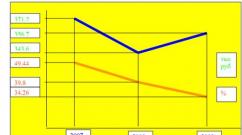Recipes with portion calculations. How to calculate the number of products for a large company
1800 kcal is the norm for a maintenance diet for an average girl who leads a moderately active lifestyle, is 165 in height and weighs 55 kg. If you want to calculate daily caloric intake for yourself, then use the form on our website, the link is directly under the logo.
Breakfast
Scrambled eggs with toast and tomato juice

Ingredients for one serving:
- Two eggs
- One piece of bread (24 g)
- 200 ml tomato juice
- Salt pepper
Are you a real foodie and you have a non-stick frying pan on which you can fry without oil? So, quickly put it on a hot burner and let it warm up properly. Meanwhile, don’t stew: break a couple of eggs into a mug to check their freshness and ensure even cooking. Yes, cut off the bread! The piece should be 5-7 mm thick or judge by weight - we expect you to eat 24 g of rye.
Are you warmed up, poor thing? Well, put the bread on the left, and pour the whites and yolks on the right side. When the protein has already sufficiently coagulated from the heat of the frying pan, please turn the toast over so that it turns out golden brown on both sides.
I won’t teach you further how to properly fry scrambled eggs, because some people like the “snotty” consistency, while others even fry the yolk. Either way, eat it immediately while the eggs are hot and the bread is soft. We suggest washing it down with tomato juice, but you can ignore our wishes and sip tea or coffee.
One serving contains: 302 kcal | 20.6 g protein | 15.5 g fat | 19 g carbohydrates
Lunch
Lazy oatmeal in a jar

The recipe is very flexible and allows you to create more and more new variations, combining different ingredients to your taste. We'll tell you a basic recipe for lazy oatmeal in a jar.
Ingredients for one serving:
- 80 g large oat flakes (i.e. NOT instant)
- 80 g plain yoghurt 1.5% fat (no sugar or fillers)
- 100 ml milk 0.5% fat
- Optional: fruits, nuts, berries, dried fruits
We take the most ordinary liter jar with a lid and pour oatmeal into it, pour yogurt, milk on top and add any topping (fruits, dried fruits, berries, nuts, etc.) Mix thoroughly, close the lid and let it brew in the refrigerator for at least an hour, or better yet, overnight .
We calculated the calorie content using the example of lazy oatmeal with apple, banana and cinnamon. To make it work, add 50 g of ripe banana, 50 g of apples and half a teaspoon of cinnamon to the basic ingredients.
One serving contains: 394 kcal | 17 g protein | 7 g fat | 76 g carbohydrates
Dinner
Buckwheat and beef stew

Ingredients for one serving:
- 60 g dry buckwheat
- 300 ml cold water
- 150 g lean beef
- 5 prunes
- 1 clove of garlic
- 1/3 medium sized onion
- salt, pepper, spices - to taste
In the evening, rinse the buckwheat and place it in a saucepan for which you have a lid. Pour water over the cereal, close the lid and leave it on the kitchen table until the morning - overnight the buckwheat will absorb all the water and you can warm it up and eat it, or just serve it cold.
There is more fuss with the meat: cut the onion into half rings, chop the garlic in any way, prunes can be put whole or cut into two parts, the meat into pieces of about 2x2 cm. Put it all in a small fireproof form, season with salt and pepper and cover with a lid/wrap with foil. This entire structure must be placed in an oven preheated to 200 degrees for about 30 minutes. Happy owners of a multicooker can add all the ingredients in the evening and set the timer so that the meat is ready in the morning.
Place buckwheat in a portioned container, top with meat and sauce - this is your lunch, which you can take with you to work.
One serving contains: 577 kcal | 32 g protein | 27 g fat | 47.5 g carbohydrates
Afternoon snack
Coffee and a quick chocolate cake “hello, Andrey!”

Ingredients for one serving:
- 1 egg
- 1 tbsp. l. Nesquik cocoa
- 3 full tbsp. regular flour
- 1 tbsp. l. milk 0.5% fat
- 1/3 tsp. baking powder
- cinnamon, cardamom, vanilla, nutmeg - optional
Break one egg into a mug, pour cocoa, flour, baking powder on top, pour in a spoonful of milk, and then stir this dough very thoroughly. Quickly put the mug in the microwave, turn it on at full power and let it swirl there for three minutes. All. It’s best to drink this miracle cake with strong coffee. Thanks to Andrey Ivchenko for the recipe.
One serving contains: 360 kcal | 18.5 g protein | 11.5 g fat | 43.4 g carbohydrates
Dinner
Pasta with chicken fillet and broccoli

Ingredients for one serving:
- 80 g farfalle pasta (ready weight)
- 80 g broccoli
- 80 g red sweet pepper
- 80 g chicken fillet
- 1 tbsp. soy sauce
- pepper, spices - to taste
Boil pasta until al dente, cut vegetables and meat into medium-sized pieces and fry in a frying pan without oil. The order is this: first of all, fry the chicken, when it is ready, throw vegetables into it, pour in soy sauce and pepper.
Cover with a lid and let simmer on medium heat for about 3 minutes. Then open the lid and dump the finished farfalle on top, stir, close the lid again, turn off the heat and let the dish sit for five minutes, and then eat.
One serving contains: 222 kcal | 25 g protein | 2 g fat | 30 g carbohydrates
TOTAL ENTIRE RATION: 1855 kcal | 113 g protein | 63 g fat | 216 g carbohydrates
And this is an example of a daily diet for 2040 kcal from Growfood:
We remind you that instead of cooking according to recipes, you can order a ready-made daily ration from 650 rubles / day from Growfood. There are options for 1000, 1200, 1400, 2000, 2500 kcal/day.
Other companies that deliver daily calorie rations: General Food (Moscow), YAMDIET (Moscow).
It is often necessary to modify recipes to increase or decrease the yield of a portion, sometimes to translate recipes taken from other sources into a standardized format, or to customize a standardized recipe for a special occasion, such as a banquet or reception. You may need to convert volumetric measures to mass or American to metric. You must be able to convert between purchasing and prescription indicators. There may be circumstances where you will be asked to increase or decrease the serving size from that specified in the recipe. You need to be able to determine the cost of ingredients for a given recipe.
Using a recipe conversion factor to recalculate yield
To increase or decrease the yield compared to that specified in the recipe, it is necessary to determine the conversion factor. Having determined it, you first multiply all the quantities of ingredients by it, then convert the new quantities into the units of measurement accepted in your kitchen. It may be necessary to convert the measures specified in the original recipe by number into mass or volume measures and round the resulting values for convenience. In some cases, you will have to rely on common sense regarding ingredients that cannot be accurately measured (such as spices, salt and thickeners).
Desired output/Initial output = Conversion factor.
Note: This formula can only be used when the desired and original outputs are expressed in the same units. If, for example, the original recipe calls for a yield of five servings, but each serving is not quantified, you may need to test the recipe to determine how much volume (weight) it produces. Likewise, if your recipe specifies yield in grams and you want to make three liters of soup, you need to convert liters to grams to determine the conversion factor.
A new quantity of an ingredient usually has to be “tweaked” a little: rounded or expressed in the most logically appropriate units. For some ingredients, simply increasing or decreasing the quantity will be enough (so to increase the yield of chicken breasts from 5 servings to 50, simply multiply by 10). With other ingredients, for example thickeners, flavorings, seasonings, yeast, things are more complicated. Just because a soup for four requires two tablespoons of flour dressing does not mean that the same soup for 40 will need 20 tablespoons (or 1.25 cups) of flour to thicken it. The only way out here is to try a new recipe and “tweak” it until the result satisfies you.
When calculating recipe yield, you also need to take into account the equipment you will be working with, the production issues you will be faced with, and the level of training of your workers. At this point, rewrite the steps to suit your establishment. It is important to do this now to identify the necessary changes in ingredients and methods caused by the new release. For example, soup for four is cooked in a small saucepan, but soup for 40 requires a large pot. But in a large boiler, evaporation is more intense, and you may have to cover the boiler with a lid or add liquid to replenish what has evaporated.
Recalculation of portion sizes
Sometimes you have to modify the serving size in a recipe. For example, your soup recipe calls for 4 0.25 liter servings, but you need to make 40 0.2 liter servings. Recalculate like this.
1. Determine the total yield in the original recipe and the total desired yield.
Number of Servings x Serving Size = Total Yield.
Example: 4 x 0.25 L = 1 L (total initial output);
40 x 0.25 L = 10 L (total desired yield).
2. Determine the conversion factor and recalculate the recipe as above.
There is often confusion between measures of mass and volume when the unit is the gram. It is important to remember that mass is measured in grams and volume in milliliters. A standard measuring cup holds 250 ml, but its contents do not necessarily weigh 250 g. One cup of cornflakes weighs only 28 g, while one cup of peanut butter weighs 255 g. The only substance for which 1 g can be safely assumed to equal 1 ml, this is water. All other ingredients, if their quantity in the recipe is expressed in grams, must be weighed, and if in milliliters, measured by volume using appropriate vessels.
Converting volume measures to mass measures
You can convert volume measures into mass measures if you know the mass of the ingredient contained in the cup (prepared according to the recipe). This information is contained in many tables and databases.
You yourself can calculate and record this information as follows.
Prepare the ingredient as directed in the recipe: sift the flour, chop the nuts, chop the garlic, grate the cheese, etc.
Place the measuring jar on the scale and bring them to zero (this is a discount on packaging).
Fill the vessel properly. Pour liquids into a graduated measuring cup to the desired level. To ensure accuracy, bend down so that the surface of the liquid is at eye level. In this case, the surface on which the vessel stands must be flat and horizontal. Measure the volume of dry ingredients using stacked measuring cups and spoons. Pour the ingredient on top and then remove the excess, leveling the level along the edges of the vessel. Place the filled container on the scale and record the reading in grams in your standardized recipe.
Conversion between American and Metric systems
The metric system used in most countries of the world is the decimal system, that is, based on numbers that are multiples of 10. The basic unit of mass is gram, volume is liter, and length is meter. Units greater and lesser than the basic ones have prefixes. For example, 1 kg = IOO g, 1 ml = 1/1000 l, and 1 cm = 1/100 m.
The system most familiar to Americans uses ounces and pounds to measure mass, and teaspoons, tablespoons, fluid ounces, cups (glasses), pints, quarts, and gallons to measure volume. Unlike the metric system, the American system does not use multiples of any specific number, so increasing and decreasing quantities is not as easy. You have to either memorize the relationship between the units or keep a table handy.
Most modern measuring instruments provide values in both systems. But if your recipe is written in a system for which you do not have a measuring tool, you will have to convert the quantities of ingredients to another system.
Calculation of purchase cost
Most often, products are purchased from suppliers in large wholesale quantities; the products are packaged in a container, box, bag, box, etc. Prices are set for a whole package of products. In the kitchen industry, the packaging is not always used entirely, but is often divided into parts and used for several dishes. This means that in order to calculate the required amount for the products used in this recipe, you need to convert the purchase price per package into a specific price - per kilogram, piece, dozen, liter, etc.
If you know the cost per package containing many units, you will find the price per unit by dividing the purchase price of the package by the number of units in it:
Total Purchase Cost / Number of Units = Unit Purchase Cost
If you know the unit cost of a product, you can calculate the total cost by multiplying the unit purchase price by the number of units:
Purchase cost per unit x Number of units = Total purchase cost.
Calculation of the yield of fresh vegetables and fruits and determination of the yield share
Many foods must be cleaned in some way before they can be used. To determine the true cost of these products, waste losses must be taken into account. Such calculations will allow you to estimate the yield share - an important factor in calculating the number of products to order. First, write down the purchase quantity or weight of the product from the invoice before trimming or cleaning.
Example. The purchasing quantity of carrots is 5 kg.
Peel the product and cut it as needed, placing the edible part and waste in a separate bowl. Weigh both and write down the masses:
Purchase quantity - Waste quantity = Quantity of edible part.
5 kg of carrots (purchase quantity) - 0.5 kg (number of peelings) = 4.5 kg (number of chopped carrots).
Now let’s divide the amount of edible part by the purchase quantity:
4.5 kg of chopped carrots (quantity of edible part) / 5 kg (purchased quantity of carrots) = 0.90.
Multiplying by 100%, we get a yield share of 90%.
Calculation of purchase quantity by output share
Since many recipes specify quantities of prepared ingredients, waste must be taken into account when purchasing. The edible part must be converted into a purchase quantity, which, after removing the waste, will give the required amount of the edible product. The order calculation coefficient is the output share:
Edible Portion / Yield Share = Purchase Quantity.
Example. The recipe indicates the amount of washed shredded cabbage - 10 kg. The yield for cabbage is 79%. Dividing 10 kg by 79% (by 0.79), we get about 12.5 kg - the minimum purchase quantity.
Typically, the purchase quantity obtained in this way is rounded up, since the yield share is approximate. Some chefs increase the result by 10% to insure against human error.
One thing to keep in mind is that not all products have waste. Many pre-processed or purified products have a yield of 100% - sugar, flour, dry spices.
There are products whose yield depends on how they are served. If, for example, the ingredient will be served in a piece (half a melon) or in pieces (15 strawberries), then the yield share does not need to be taken into account; It is enough to purchase the required number of pieces for the required number of servings.
If you're making a fruit salad and you know you need 60g of diced melon and 30g of sliced strawberries per serving, then you should consider the yield percentage when ordering the fruit.
Calculation of edible part by yield share
Sometimes you need to calculate how many servings can be made from the available raw materials. For example, you have a ten-kilogram box of fresh green beans, and you need to know how many 100-gram servings it contains. First of all, you need to determine the yield percentage for green beans - either from a special table (see appendix) or by sampling. Knowing the yield fraction, you can calculate the amount of beans after peeling:
Purchase Quantity x Yield Share = Quantity of Edible Part.
Example. 10 kg green beans (purchase quantity) x 0.88 (output share) = 8.8 kg green beans (edible quantity).
The amount of edible part will be 8.8 kg. The next step is to calculate how many finished servings you will get from 8.8 kg. If necessary, convert the serving size (here 100 g) to the unit of measurement in which the edible portion is given (here kilogram). A serving is 0.1 kg.
Edible Portion / Serving Size = Number of Servings Served.
Example. 8.8 kg green beans (edible portion amount) / 0.1 kg (serving size) = 88 servings served.
So, from a box of green beans, you can get 88 full servings. If necessary, you need to round down here - you are unlikely to serve a reduced portion to your guest.
Calculation of the cost of the edible part
As mentioned, the ingredients in recipes are considered ready to go, so when it comes to costing the recipe, the cost of the edible portion per unit can be calculated based on the purchase price per unit, if, of course, the edible portion is expressed in the same units as and costable unit of production.
Purchase Cost / Yield Share = Cost of edible portion.
Example. 40 rub. for 1 kg of carrots / 0.75 (share of output of shaped carrots) = 53.3 rub. (cost of 1 kg of shaped carrots).
Quantity of edible part x Cost of edible part = Total cost.
4 kg of shaped carrots (purchase quantity) x 53.3 rub. (cost of 1 kg of shaped carrots, that is, the cost of the edible part) = 213.2 rubles. (total cost).
Calculation of the cost of suitable waste
It happens that some of the waste can be used to prepare other products. For example, if you cut carrots into shapes, you can increase their efficiency by using the trimmings to make soup, puree, or other dishes. Using your waste sample data, you can calculate the useful value of the waste. Determine the amount of waste used, then calculate the unit cost and yield for a given ingredient, as if you were to purchase it to prepare a dish. For example, if you use scraps from chopped carrots to make soup, their cost is the same as the cost of carrots that you peeled and cut.
Example. 40 rub. (purchase cost of carrots per 1 kg) / 0.90 (share of output of chopped carrots) = 44.4 rubles. (cost of 1 kg of carrot waste used to make soup).
Waste from some products can be used in several ways. So, fillet trimmings can be used in different ways. For example, you can use some of the trimmings to make a filling for fajitas (a Mexican corn tortilla stuffed with fried meat) that would otherwise require purchasing the tenderloin. In addition, some restaurants sell the trimmed fat to fat processing plants. Finding new ways to use waste reduces the cost of the edible part and the overall cost and helps reduce costs.
Whatever event is planned, the calculation of products will always be standard. It has long been determined by many restaurateurs and chefs that the average food allowance by weight per person should not be less than 1000 grams. If it is less, your guests will be upset when they see a half-empty table and will leave hungry. But you shouldn’t overdo it either. Maximum weight - 1500 grams per person. If you cook more, you will have to fill the refrigerator and then take a long time to finish eating.
Making a menu
Any table should be varied. It doesn't matter what you're planning - a wedding banquet or a picnic; in any case, cold appetizers are served first. And here the choice should be quite large: after all, it is the cold appetizers that will be on the table until the end of the event (they are good for both a snack and a snack with alcohol). Fish, meat, vegetable, and cheese snacks are traditional; every guest can find something to their liking. They are usually served at the rate of 300 grams of total weight per person.
If your event involves hot appetizers(which is not at all necessary), then their minimum weight is 100 grams per person. Most often, hot snacks are served in portions: various julienne dishes, vegetables, pancakes.
Another traditional dish for the feast is salad. The optimal number of salads on the table is three: one of them should be simple and familiar to most guests (most likely meat), the second should be vegetable or fish, and the third should be your original salad. Calculation of weight for salads is done in this way - approximately 100 grams of each type of salad per guest.
Things have gotten hot. If you are having a festive banquet, then there should be two types of hot dishes on the table, which are traditionally divided into fish and meat. Don’t forget about the side dish - there’s one for each hot dish. The calculation is as follows: 250 grams of the main dish, 150 grams of the side dish.
As you know, at long banquets before dessert Not everyone “survives.” But for many of your guests, dessert will be long-awaited and joyful. Therefore, the preparation of the so-called final dish must be treated with no less attention. Cake or pastries, portioned desserts - ice cream, jelly, puddings - are calculated at a maximum of 150 grams per person.
In addition to the main dishes don't forget about fruits. When you are preparing to receive a large number of guests, it is better to purchase small fruits: grapes, medium-sized apples, tangerines. If you have time to prepare fruit, you can make sliced fruit plates. Such plates will decorate the holiday table. Fruits are purchased at the rate of 200 grams of total weight per person.
Choosing drinks
When choosing alcohol for a large-scale event, you need to remember one important point: if you don’t know the company’s preferences well, it is best to take classic alcohol - champagne, wine, vodka. Various original drinks - rum, tequila, martini - can only be purchased if you clearly understand that your guests drink exactly them.
Calculating alcohol is a little more complicated than food; there is also a gender principle here. If the majority of your company is men, we calculate this: 0.75 liters of wine, 0.7 liters of vodka, 0.3 liters of champagne for each guest. If the company is mainly female, the calculation is different: 1.2 liters of wine, 0.5 liters of vodka, 0.5 liters of champagne.
A must on any table both juice and water must be present. Moreover, it is advisable to choose several types of juices, including fruit drinks, at the rate of 1.5 liters per person (in summer it is better to take 2 liters). Water is usually offered in two types: with gas and without gas at the rate of 0.5 liters per person (and there should be more water without gas than with gas).
Don't forget about tea and coffee for dessert!
Let us separately dwell on the intricacies of preparing for a picnic. In general, the approach to grocery shopping will be the same. It is only worth noting that the traditional dish for a picnic is, of course, shish kebab, for the preparation of which you need to buy two types of meat: pork (or lamb) and chicken (or turkey). As a rule, meat for barbecue is prepared at the rate of 300-400 grams per person. Of course, you can take more fresh vegetables and herbs (about 300 grams each).
registration on the site
Before using FOODCOST, users must register. Link to registration form
In the window that opens, select the tab Registration and fill out all form fields:
- Specify Name And Last name.
- Think and enter Login, which should contain only Latin letters.
- Please provide a real email address where you can be contacted.
- Password may contain letters of the Latin alphabet and numbers.
- Reenter password.
- Select your main profile to optimally customize the interface and click the button Registration
Attention!!!
Do not use your email address as a login!
Using Cyrillic and special characters in the login NOT ALLOWED!
Attention!!!
Using Cyrillic characters in the password NOT ALLOWED!
After completing the registration procedure, a message with a link to activate your account will be sent to your email address. Without account activation, your account will remain inactive!
Authorization on the site
To start using FOODCOST services, users must log in. Link to authorization form located on the top panel of the site. Clicking on this link will open the Authentication window.
Search for recipes
To open the recipe search form, click the button Find the recipe located on the top panel of the site.
In the window that opens, you must specify the recipe parameters that it must comply with.
- Name of the dish- a word or phrase included in the name of the dish
- Menu group- select from the list the menu group that includes the dish.
- Highlight additional properties of recipes: Free TTK Recipes and ready-made TTK (technical and technological maps), access to which is provided free of charge (without a subscription). Only for authorized users!!! School meals Recipes and ready-made technical instructions (technological maps) for kindergartens (preschool educational institutions) and schools. Medical nutrition Recipes and ready-made technical instructions (technological maps) for medical nutrition. Lenten dishes Recipes and ready-made TTK (technical and technological maps) and TC (technological maps) of dishes and culinary products, in the preparation of which no products of animal origin are used.
- Composition of the dish- if necessary, select from the list the main products from which the dish is prepared.
- National cuisine- from the list you can select the cuisine to which the dish belongs.
By the way...
When selecting this option, selection will be made only from the specified section group Portioned dishes our Collection of Recipes.
If you need to include all sections of the Collection of Recipes in the search, set the flag Search in blanks and semi-finished products. In this case, there is no need to specify a menu group!
After specifying all the necessary parameters, click the button Find the recipe.
To quickly clear all filter parameters, click the Reset button
If, when creating a request, you specified Menu section, the group you selected from the section will open Portioned dishes and a list of dishes that meet the previously specified properties.
If you used the search in all sections (checked the Search in blanks and semi-finished products property), you will see common list recipes for dishes and culinary products that meet the previously stated properties.
Site search
The site is searched in all sections, including recipes, news, regulatory documents, product directories and company directories.
To call the search string, click the button located on the top panel of the site.
In the line that opens, enter a search query and press Enter
Rationale for use
The collection of recipes was compiled on the basis of control studies and compares favorably with other analogues in that it contains the most frequently used recipes in modern practice.
The recipes published in the Collection can be successfully and absolutely legally used in public catering establishments, because they comply with all currently valid laws and regulations.
Regulatory documents on certification and standardization in force on the territory of the Russian Federation include industry standards (a set of business entities, regardless of their departmental affiliation and forms of ownership, developing or producing certain types of products that have a homogeneous consumer purpose); enterprise standards; scientific and technical and a number of other standards.
Standards are developed and approved by enterprises independently, based on the need for their application in order to ensure the safety of life, human health and the environment. When producing the products described in the Collection, the manufacturer has the right to make some changes to the recipes of dishes, expand the lists of components, while avoiding violations of sanitary rules, the technological regime of product production, or deterioration of its consumer properties and qualities.
Not everything is clear?...
Learning to work with FOODCOST services is not difficult, but it will require attention and a certain amount of perseverance. Various types of reference information will help with this, links to which are located in the User Support Center.
Reference information includes.
The popularity of catering outlets will never fade, because human laziness and love for food are eternal. Indeed, not everyone, having desired the Stolichny salad, chicken Kiev and Prague cake for dessert, can afford to rush to the store in order to buy everything they need and lock themselves in the kitchen, cooking for several hours. The harsh reality of work, traffic jams and fatigue dictates its own rules, but you still want to eat delicious food. Entrepreneurial people who have managed to build a serious business out of a successful kitchen have been successfully making money on these human weaknesses for many years. How to correctly calculate the cost of a meal in a canteen so as not to work at a loss, or, conversely, not to scare away potential customers with exorbitant prices? At the same time, golden hands are not enough for success, because the market and competition dictate their own rules. It would seem - a canteen and a canteen, what can you earn there? However, people’s attachment to the classics, when they were still cooking according to the “Book of Tasty and Healthy Food,” is worth a lot.
On fingers
To tell the truth, at the moment the cost output is overestimated, since it is more logical to form the final price of a menu item based on people’s tastes, demand and average market requests, however, for internal tracking of costs and leveling of expenses, costing of dishes is still recommended.
For example, let’s take one of the currently popular French-style confectioneries: the company uses high-quality raw materials with a corresponding price tag, uses special equipment for preparing its products, which is quite expensive (for example, the same fully automated device for tempering chocolate - you can’t save money on it will work out, since this is fraught with failures and damage to expensive resources), rents a room of the required area, etc., etc. The costing of dishes is in full view, but they cannot reduce costs, since the quality, name and, as a result, demand will suffer, so they have to keep the bar. They also cannot put a uniformly high markup on those items that are roads themselves, and those 300% of the cost that are rumored by the population are simply brushed aside. So what should you do? Let's look at the menu that the confectionery offers:
- yeast baked goods;
- cakes and pastries;
- marshmallow candies.
The first and third positions in terms of cost, if not cheap, are close to it, while it is impossible to “screw up” even half of the cakes due to expensive resources. Therefore, the second position is sold significantly cheaper, and the difference is made up by buns and sweets. Moral: calculating the cost of a dish is not always based on the purchase prices of its components.
Of course, a confectionery shop is different from a canteen, but the principle of working with final food products is similar.

Where to begin?
Those who are especially lazy can use ready-made online templates that can be found everywhere on the Internet, but they are too general and quite rough to calculate. It would be more correct to display prices yourself once and stick to them in the future, adjusting based on demand. In order to display the correct calculation of dishes in the dining room, you must have on hand:
- a completed menu, which will indicate a list of dishes provided by the catering outlet;
- technological maps for each menu item;
- purchase prices of all products that are involved in the preparation of menu items.
Menu
A little advice: when choosing dishes for the dining room, do not overdo it. The very definition of this catering outlet implies simple, unsophisticated food that can evoke nostalgia for the times of the Union. In other words, no sushi. And the abundance of complex items will make calculating dishes, if not more problematic, then certainly more boring. A list as thick as an encyclopedia is difficult to maintain both professionally and financially, since it is difficult to find general-purpose chefs for a canteen, and maintaining the required composition of products on an ongoing basis is expensive.

Technological maps
This term refers to a document that contains information about all the features of a dish. It includes the following data (not necessarily all, some are selective):
- Duration and specifics of storage of the dish. Conventionally: ice cream at a temperature of -18...-24 o C is stored for 3 months, while bread, at a temperature of +20...+25 o C, is stored for 72 hours;
- nutritional value of the finished dish: number of calories, in some cases - protein/fat/carbohydrate ratio;
- requirements for the sale and serving of finished dishes;
- the recipe itself, which includes the composition and cooking algorithm;
- recipe source;
- description of the appearance, principle of decorating the dish;
- weight of the finished portion.
You cannot neglect the technological map, since the principles of work “at random” and “by eye” will only please you until the first fine from the supervisory authorities.
You can acquire this document in two ways - purchase a ready-made one, which will be made to order for you, or withdraw it yourself. The first one is downright expensive, but the second one is not complicated, as we will prove below.

Example
Menu item name: Chicken Kiev.
Technological map No. 47.
Dishes: roasting.
Expected yield of the finished dish (serving size): 310 grams.
Product layout per 100 grams of finished dish:
- peeled chicken fillet - 29.82 grams;
- butter - 14 grams;
- chicken egg - 3.27 grams;
- bread made from premium flour - 8.88 grams. The expected weight of the semi-finished product at the exit is 50.35 grams;
- for frying - 5.21 grams;
- side dish bean (technological map No. 741) or potato (technological map No. 42) - 52.08 grams.
dish, its chemical composition and calorie content, recipe
The beaten chicken fillet is stuffed with butter, dipped in eggs, double-breaded in ground white bread, and deep-fried in hot water for about 6-7 minutes until a rich golden brown crust forms. Place on a baking sheet and bring to readiness at a temperature of 200-220 o C in the oven. Products are optionally served on warmed toast. The default side dish is bean or vegetable.
Purchase prices for products
An item without which it is impossible to calculate food in the dining room. Ideally, it is worth adding transportation costs to them if the raw materials are brought not by the supplier, but by you yourself, through the mediation of transport companies or on your own. Also take into account the funds spent on loading/unloading, if these services are paid separately.
Counting principle
Having the information described above in hand, the matter remains small.
It is necessary to indicate the name of the dish,, based on the technological map, put down those products that are required in the required quantity, indicate the derived purchase prices and summarize. That's all, you have received the cost of the dish.

Let's move on to practice
Calculation of the dish (for example, the same chicken Kiev, we take the average prices for the capital):
- peeled chicken fillet - 29.82 grams, where 1000 grams costs 180 rubles;
- manufactured according to GOST) - 14 grams, where 1000 grams costs 240 rubles;
- chicken egg - 3.27 grams, where 1000 grams costs 120 rubles;
- bread made from premium flour - 8.88 grams, where 1000 grams costs 60 rubles;
- for frying - 5.21 grams, where 1000 grams costs 80 rubles;
- side dish bean (technological map No. 741) or potato (technological map No. 42) - 52.08 grams, where 1000 grams costs about 50 rubles.
As a result we get:
- chicken fillet, skinned and boned - 5.37 rubles;
- butter (real, made according to GOST) - 3.36 rubles;
- chicken egg - 0.4 rubles;
- bread made from premium flour - 0.54 rubles;
- cooking fat for frying - 0.42 rubles;
- side dish bean (technological map No. 741) or potato (technological map No. 42) - 3.12 rubles.
Thus, we get the calculation of the dish in the “Cutlet Kiev” canteen: the cost of 100 grams of serving is 13 rubles 20 kopecks.

The same principle is used to calculate all items listed on the menu, including side dishes, desserts and drinks.
Of course, prices are unstable, and it is at least irrational to rewrite the cost manually from time to time, so you can create dish templates in any program that allows you to count, for example Microsoft Excel. Simply enter the components, write the calculation formula and adjust the purchase price when it changes.
If you plan to implement automated accounting, then everything is completely elementary - almost all trading programs “tailored” for public catering systems have the “dish calculation” option. Moreover, it is revealed not only in the possibility of posting the current purchase price of ingredients on the corresponding lines - also, in real time, movement and write-off are carried out. Thanks to this, you can always track step by step where, figuratively speaking, “2 kilograms of oil disappeared.”
Practical use
As mentioned earlier, the calculation of costing at the moment only indirectly affects its selling price, since the latter is formed under the influence of a number of characteristics, including the market average, resources spent on other menu items, as well as such banal needs , as ensuring the full functioning of the canteen. The latter indicates the price level that must be maintained for the profitability of the enterprise in general.

By and large, the canteen is a fairly profitable enterprise, since the standard list of dishes, which is usually an honor for this kind of establishment, is distinguished by a frankly low purchase price without losing its useful qualities. Relatively speaking, the preparation of the same vinaigrette or pickle takes a minimum of money, and the people’s love for them is close to the concept of “eternity.” Calculation of dishes can show the organization’s accounting department how profitable certain assortment items are, whether it is necessary to introduce something new or, conversely, remove dishes that do not pay for themselves.














